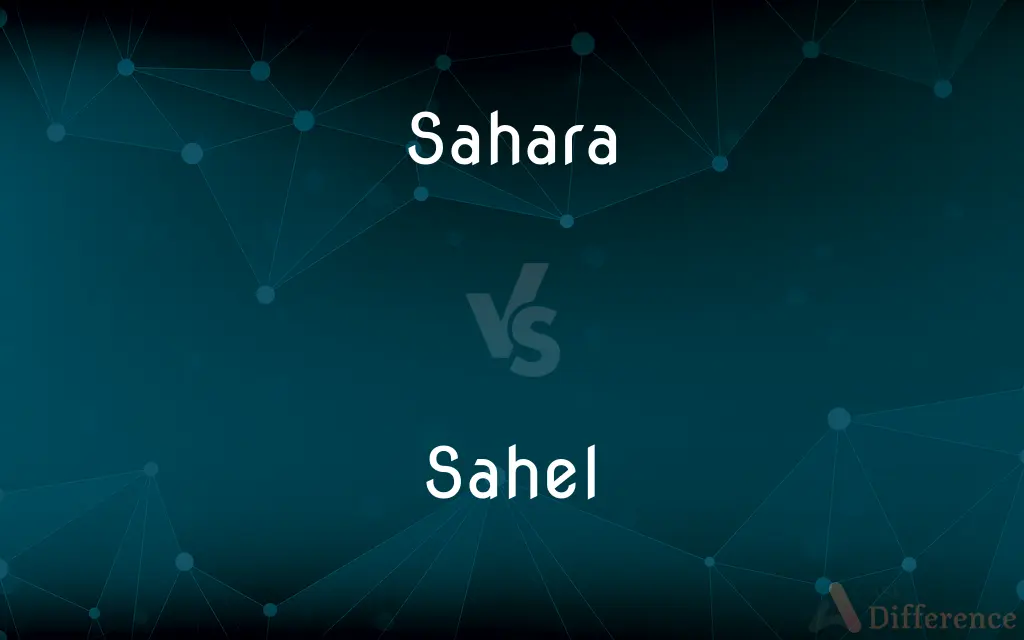Sahara vs. Sahel — What's the Difference?
By Tayyaba Rehman & Urooj Arif — Updated on April 26, 2024
The Sahara is the world's largest hot desert, characterized by its vast sandy landscapes and extreme temperatures, whereas the Sahel is a semi-arid region that serves as a transitional zone between the Sahara to the north and savannas to the south.

Difference Between Sahara and Sahel
Table of Contents
ADVERTISEMENT
Key Differences
The Sahara Desert, covering most of North Africa, is known for its harsh environment and sparse rainfall, receiving less than three inches of rain annually. In contrast, the Sahel, which stretches from Senegal to Sudan, experiences slightly more rainfall, ranging from six to twenty inches per year, supporting more varied vegetation and wildlife.
While the Sahara is primarily sandy with massive dunes and rocky plateaus, the Sahel features a mix of grasslands, savannas, and sparse forests. This difference in vegetation affects the types of wildlife and agricultural practices in each region.
The Sahara's climate is one of the most extreme on Earth, with daytime temperatures that can soar above 50 degrees Celsius (122 degrees Fahrenheit) and drop significantly at night. On the other hand, the Sahel experiences less severe temperature fluctuations, although it can still be extremely hot, especially in the dry season.
Historically, the Sahara was not always a desert; it underwent desertification thousands of years ago. Meanwhile, the Sahel is currently facing a risk of further desertification due to climate change, overgrazing, and deforestation, which threatens its already fragile ecosystem.
The populations in the Sahara are sparse, with communities mainly consisting of nomadic tribes like the Tuareg and Berbers, who have adapted to the harsh desert life. In contrast, the Sahel hosts a larger population with more settled agricultural communities, although it still faces significant challenges such as food insecurity and political instability.
ADVERTISEMENT
Comparison Chart
Location
North Africa
Just south of the Sahara across Africa
Climate
Arid, extremely hot and dry
Semi-arid, hot with seasonal rainfall
Average Rainfall
Less than 3 inches per year
6 to 20 inches per year
Landscape
Sandy deserts, dunes, rock plateaus
Grasslands, savannas, sparse forests
Key Challenges
Extreme temperatures, limited water sources
Desertification, political instability
Compare with Definitions
Sahara
A region with extreme climate conditions.
Temperatures in the Sahara can reach over 50 degrees Celsius.
Sahel
Supports grasslands and sparse forests.
The Sahel's landscape is characterized by savannas and scattered trees.
Sahara
The largest hot desert in the world.
The Sahara is known for its vast expanses of sand and dunes.
Sahel
Prone to desertification.
Overgrazing and deforestation have increased desertification risks in the Sahel.
Sahara
Sparse in vegetation and wildlife.
The Sahara's arid conditions support only hardy desert plants.
Sahel
Faces challenges like food insecurity.
The Sahel struggles with frequent droughts that affect food production.
Sahara
Home to nomadic communities.
The Tuareg people travel across the Sahara, adapting to its harsh environment.
Sahel
A semi-arid transition zone in Africa.
The Sahel stretches between the harsh Sahara and the lush savannas.
Sahara
Experiences significant temperature drops at night.
Nighttime in the Sahara can be surprisingly cold compared to the daytime heat.
Sahel
More rainfall than the Sahara.
The Sahel receives up to 20 inches of rain annually, allowing for more diverse agriculture.
Sahara
The Sahara (, ; Arabic: الصحراء الكبرى, aṣ-ṣaḥrāʼ al-kubrá, 'the Greatest Desert') is a desert on the African continent. With an area of 9,200,000 square kilometres (3,600,000 sq mi), it is the largest hot desert in the world and the third largest desert overall, smaller only than the deserts of Antarctica and the northern Arctic.The name "Sahara" is derived from the Arabic word for "desert" in the feminine irregular form, the singular ṣaḥra' (صحراء /ˈsˤaħra/), plural ṣaḥārā (صَحَارَى /ˈsˤaħaːraː/), ṣaḥār (صَحَار), ṣaḥrāwāt (صَحْارَاوَات), ṣaḥāriy (صَحَارِي).
Sahel
The Sahel (; Arabic: ساحل sāḥil [ˈsaːħil], "coast, shore") is the ecoclimatic and biogeographic realm of transition in Africa between the Sahara to the north and the Sudanian savanna to the south. Having a semi-arid climate, it stretches across the south-central latitudes of Northern Africa between the Atlantic Ocean and the Red Sea.
Sahara
The world's largest desert (3,500,000 square miles) in northern Africa
Common Curiosities
How do the landscapes of the Sahara and Sahel differ?
The Sahara features expansive sandy deserts and dunes, while the Sahel includes grasslands and sparse forests.
What causes the nighttime temperature drops in the Sahara?
The lack of humidity in the Sahara allows heat to escape rapidly at night, leading to significant temperature drops.
Are there any unique wildlife adaptations in the Sahara?
Yes, wildlife in the Sahara has adapted to extreme dryness and heat, such as the fennec fox with its large ears for heat dissipation.
What challenges does the Sahel face that the Sahara does not?
The Sahel faces severe risks of desertification and political instability, impacting its more substantial population.
Why is the Sahel important for understanding climate change?
The Sahel is crucial for studying climate change due to its sensitivity to weather patterns and its current experience with desertification.
How do people adapt to living in the Sahara?
People in the Sahara adapt through nomadic lifestyles, using knowledge of oasis locations and adapted cultural practices.
What is the main climate difference between the Sahara and the Sahel?
The Sahara is arid with very little rainfall, while the Sahel is semi-arid with slightly more moderate rainfall.
What historical changes have occurred in the landscape of the Sahara?
Historically, the Sahara underwent desertification from a once more hospitable environment thousands of years ago.
Is there any cultural heritage unique to the Sahara?
The Sahara boasts rich cultural heritage, including ancient rock art and traditional music of the nomadic tribes.
How does rainfall affect the lifestyle in the Sahel compared to the Sahara?
The slightly higher rainfall in the Sahel supports agricultural activities, unlike the sparse nomadic lifestyle in the Sahara.
Can the Sahara support any form of agriculture?
Traditional agriculture is nearly impossible due to the extreme aridity, though oasis farming is practiced in some areas.
What initiatives are in place to combat desertification in the Sahel?
Various international and local initiatives aim to restore land, such as the Great Green Wall project, which intends to halt the advancing desert.
What types of governments are prevalent in the Sahel?
The Sahel region includes a variety of government forms, but many countries face challenges with stability and governance.
How do economic activities in the Sahel compare to those in the Sahara?
The Sahel has more diverse economic activities, including limited agriculture and livestock farming, compared to the Sahara's minimal economic diversity.
What are the major environmental concerns in the Sahel?
Major concerns include increasing desertification, loss of arable land, and the effects of climate variability.
Share Your Discovery

Previous Comparison
Billion vs. Trillion
Next Comparison
Manchego vs. ParmesanAuthor Spotlight
Written by
Tayyaba RehmanTayyaba Rehman is a distinguished writer, currently serving as a primary contributor to askdifference.com. As a researcher in semantics and etymology, Tayyaba's passion for the complexity of languages and their distinctions has found a perfect home on the platform. Tayyaba delves into the intricacies of language, distinguishing between commonly confused words and phrases, thereby providing clarity for readers worldwide.
Co-written by
Urooj ArifUrooj is a skilled content writer at Ask Difference, known for her exceptional ability to simplify complex topics into engaging and informative content. With a passion for research and a flair for clear, concise writing, she consistently delivers articles that resonate with our diverse audience.















































